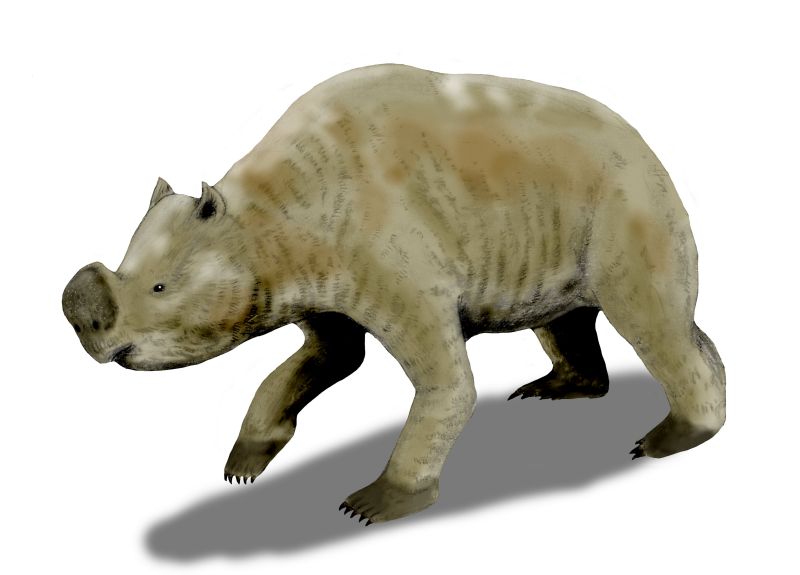- Zygomaturus
Taxobox
name = "Zygomaturus"
fossil_range =Pleistocene

image_caption = Restoration of "Zygomaturus trilobus"
image_width = 275px
regnum =Animal ia
phylum = Chordata
classis =Mammal ia
infraclassis =Marsupialia
ordo =Diprotodontia
subordo =Vombatiformes
familia =Zygomaturidae
genus = "Zygomaturus"
subdivision_ranks = Species
subdivision = †"Zygomaturus diahotensis "
†"Zygomaturus gilli "
†"Zygomaturus keanei "
†"Zygomaturus keani "
†"Zygomaturus tasmanicus "
†"Zygomaturus trilobus ""Zygomaturus" is an
extinct giantmarsupial fromAustralia during thePleistocene . It had a heavy body and thick legs and is believed to be similar to the modernPygmy Hippopotamus in both size and build.cite book| last = Ellis| first = Richard| authorlink = Richard Ellis (biologist) | title = No Turning Back: The Life and Death of Animal Species| publisher = Harper Perennial | date = 2004| location = New York| pages = 101| isbn =0-06-055804-0 ] The genus moved on all fours. It lived in the wetcoastal margins of Australia about 19,000 years ago. "Zygomaturus" also is believed to have expanded its range toward the interior of thecontinent along thewaterways . It is believed to have lived in smallherds . "Zygomaturus" probably atereed s and sedges by shoveling them up in clumps with its lowerincisor teeth .Related species
References
Further reading
*"Wildlife of Gondwana: Dinosaurs and Other Vertebrates from the Ancient Supercontinent (Life of the Past)" by Pat Vickers Rich, Thomas Hewitt Rich, Francesco Coffa, and Steven Morton
*"Marsupial Nutrition" by Ian D. Hume
*"Prehistoric Mammals of Australia and New Guinea: One Hundred Million Years of Evolution" by John A. Long, Michael Archer, Timothy Flannery, and Suzanne Hand
*"Life of Marsupials" by Hugh Tyndale-Biscoe
*"Magnificent Mihirungs: The Colossal Flightless Birds of the Australian Dreamtime (Life of the Past)" by Peter F. Murray, Patricia Vickers-Rich, and Pat Vickers Rich
*"Classification of Mammals" by Malcolm C. McKenna and Susan K. Bell
*"Australia's Lost World: Prehistoric Animals of Riversleigh" by Michael Archer, Suzanne J. Hand, and Henk Godthelp
* "World Encyclopedia of Dinosaurs & Prehistoric Creatures: The Ultimate Visual Reference To 1000 Dinosaurs And Prehistoric Creatures Of Land, Air And Sea ... And Cretaceous Eras (World Encyclopedia)" by Dougal DixonExternal links
* [http://www.heysentrail.sa.gov.au/naracoorte/wonambi/animals/extinct/005827 Extinct Animals - Zygomaturus trilobus]
* [http://www.gondwanastudios.com/info/zygomaturus.htm Zygomaturus at Gondwana Studios]
* [http://museumvictoria.com.au/prehistoric/mammals/diprotodontids.html The Diprotodontids]
Wikimedia Foundation. 2010.
